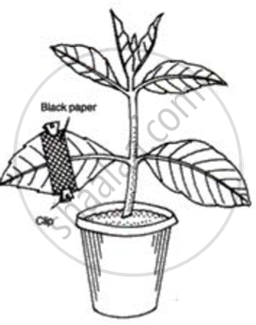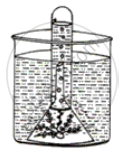Advertisements
Advertisements
प्रश्न
The diagram alongside represents an experiment conducted to prove the importance of a factor in photosynthesis.

Study the same and then answer the questions that follow:
(i) Name the factor being studied in his experiment.
(ii) Why was the plant kept in a dark room before conducting the experiment?
(iii}Why was the experimental leaf then kept in
1. boiling water 2. methylated spirit?
(iv) Name the solution used to test for the presence of starch in the leaf.
(v) What will we observe in the experimental leaf at the end of the starch test?
(vi) Give a balanced chemical equation to represent the process of photosynthesis.
उत्तर
(i) Sunlight
(ii) To destarch the leaf.
(iii) (1) The leaf was kept in boiling water to kill the cells/ releases the starch grains.
(2) It is kept in methylated spirit to remove chlorophyll.
(iv) Iodine
(v}At the end of the starch test it is observed that the covered part of the leaf remains brown and the exposed part of the leaf remains blue-black.
(vi) \[\ce {6CO2 + 12H2O ->[Sunlight][Chlorophyll]C6H12O6 + 6O2 + 6H2O}\]
APPEARS IN
संबंधित प्रश्न
The diagrams given below represent the relationship between a mouse and a physiological process that occurs in green plants. Study the diagrams and answer the questions that follow

(i) Name the physiological process occurring in the green plant that has kept the mouse alive.
(ii) Explain the physiological process mentioned above.
(iii) Why did the mouse die in bell jar B?
(iv) What is the significance of the process as stated in (i) for life on earth?
(v) Represent the above mentioned physiological process in the form of a chemical equation.
Give appropriate biological/technical terms for the following:
An apparatus that measures the rate of water uptake in a cut shoot due to transpiration.
State the main functions of the following:
Cytokinins
Define the following:
Plant pigments
Distinguish between the following:
Photosynthesis and photophosphorylation.
An experiment was set up as shown in the figure alongside. Look at the figure and answer the following questions:
( i) What is the objective of this experiment?
( ii ) Which plant is used in this experiment?
( iii ) Which gas is evolved in this process?
( iv ) What will happen to the rate of evolution of this gas if a pinch of sodium
bicarbonate is added?
(v ) What will happen if the apparatus is kept in dark?

Name the following:
Three organisms that cannot prepare their own food by photosynthesis.
The following statement is about photosynthesis in a green plant. Write whether it is True or False.
Photosynthesis occurs in underground organs as well as in aerial ones.
Fill in the blanks:
The end products of photosynthesis are ______ and ______.
How does carbon dioxide return to the atmosphere? Explain.
A student in order to study the importance of certain factors of photosynthesis took a potted plant and kept it in the dark for over 24 hours. Then in the early hours of the morning the student covered one of the leaves with black paper in the centre only. Student placed the potted plant in the sunlight for a few hours, and then tested the leaf which was covered with black paper for starch.
(i) What aspect of photosynthesis was being investigated?
(ii) Is there any control in this experiment? If so, state the name.
(iii) Why was the plant kept in the dark before the experiment?
(iv) Describe step by step how the candidate proceeded to test the leaf for the presence of starch.
If the rate of respiration becomes more than the rate of photosynthesis, plants will:
What are the basic requirements of photosynthesis?
What is meant by the photolysis of water?
Respiration is said to be the reversal of photosynthesis.
The figure given below is for performing an experiment on photosynthesis.

Answer the following:
(i) What is the aim of this experiment?
(ii) Describe an experiment to show that light is necessary for photosynthesis.
(iii) What do you conclude from this experiment?
(iv) What is the role of light in photosynthesis?
Choose the correct option.
In presence of high concentration of oxygen, RuBP carboxylase converts RuBP to ______.
______ is ATP factory of the cells.
What is photosynthesis and wherein a cell does occur?
Name the minute openings seen on the lower surface of the leaf.
